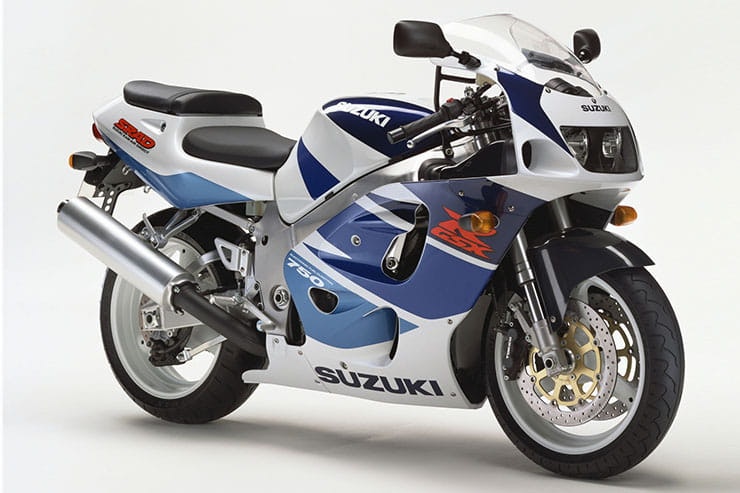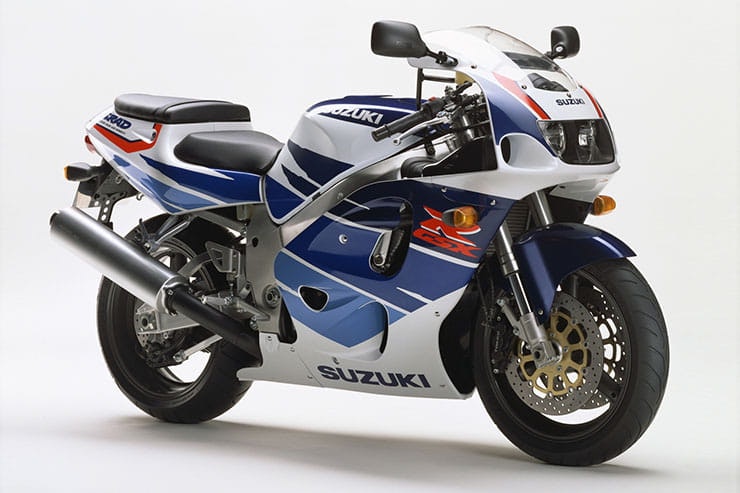Suzuki GSX-R750 SRAD (1996 - 1999): Review & Buying Guide
By Jon Urry
Massively experienced road tester
16.08.2022
When the all-new Suzuki GSX-R750 SRAD WT first appeared in 1996 it caused a sensation, mainly down to some clever marketing. Launched alongside a picture of its silhouette laid over Kevin Schwantz’s 1993 world-title-winning RGV500 GP bike, this image demonstrated that the new road bike had the same wheelbase and rake as the racer. As you could imagine, this got everyone very, very excited. Had Suzuki finally built a bike that could win the World Superbike title against the all-conquering, and ultra-exotic, Ducatis? Err, sadly not...
Despite the best efforts of Harris Performance, who ran the WSB team for three seasons before it switched to the Alstare effort in 1999, track success was lacking on the world scene (it took four WSB wins but did ok in domestic and endurance racing) and so the SRAD’s sales ran out of steam, especially when the R1 appeared in 1998 and stuck the final nail in the 750 class’s coffin. But the SRAD is still a very fondly remembered bike that is starting to enjoy a new wave of popularity.
An iconic 1990s design of bike thanks to its bulbous tail, the SRAD (which stands for Suzuki Ram Air Direct) and its many (and fairly hideous...) paint schemes is now seeing a resurgence in popularity with not only road riders but also racers. In fact, Michael Dunlop will be lining up on a Team Classic Suzuki 1996 SRAD for the new-look Manx Grand Prix on the Isle of Man, a bike that looks absolutely stunning with its Lucky Strike inspired blue paint scheme.
If you are after a reminder of the 1990s superbike glory years, the SRAD is a great buy that certainly won’t disappoint when it comes to the ride.
Suzuki GSX-R750 SRAD (1996-1999) Price
Strangely, GSX-R models tend not to be viewed as collector’s items and that means the SRAD remains fairly good value. You can pick up a hack for as little as £1500, which would make a great trackday bike, with decent ‘useable’ ones generally costing between £2500 and £3000. There are a few priced in the £4000-£5000 region but these are absolute minters. With the SRAD there are a few colour options that add value. Most riders want the classic Suzuki blue/white, so grey and red options are often cheaper, but the hideous (depending on your opinion...) purple is ‘rare’ and therefore more expensive and the weird bronze is also quite sought after, so expect to pay a bit more for either of these. There isn’t really much price difference for carbs vs injected bikes as buyers don’t generally care which system it runs as both have their respective pros and cons.
Power and torque
The inline four engine was all-new for 1996 and as it has a big bore/short stroke design when compared to previous GSX-R750 models it is quite rev-happy. Although Suzuki claimed it made 128bhp (135bhp on injected bikes, which arrived in 1998) the rear wheel reality is just under 120bhp so it can feel a bit gutless in a modern context. Assume it will behave like a supersport 600 with a bit more mid-range and you won’t be disappointed.
Engine, gearbox and exhaust
The SRAD’s engine is a fairly robust unit but it does have a few issues that can bite the unwary buyer. The first thing to check for is any sign of cam chain tensioner issues, which generally manifest as a clattering sound when the bike is started from cold. The tensioner is a bit weak and on older bikes can fail, causing catastrophic damage to the motor’s top end. If this is good, check the gearbox (which was changed with new ratios in the 1998 update) on a test ride as they are a bit fragile and can hop out of gear under hard acceleration. If you are looking at a carbed bike, be a bit cautious if it doesn’t require any choke to start from cold as this could mean the carbs are worn and fuel is escaping past bits that should be sealing, making it run rich and therefore start from cold easier! If the bike runs a bit fluffily and doesn’t fuel well, assume the carbs are in need of a strip, clean and balance. A lot of companies will do this and you can expect to pay about £300 for them to complete the job or you can quite easily do it yourself, there are a lot of guides on the internet if you get stuck. As the SRAD is getting on a bit now, be wary of old fuel lines (there was a recall for a fuel pump hose many years ago) and changing them isn’t a bad idea for safety reasons. As you would expect from a 1990s superbike, aftermarket exhaust cans are very, very common and the quality is quite varied. If it has a ‘known’ brand (ideally Yoshimura) that’s great, if not then try and buy one with an OE can instead. Check the headers for rot and while you are in the area, inspect the radiator well for any leaks or damage as it is costly to replace. Some owners remove the flapper valve in the SRAD’s airbox on injected bikes to gain a few bhp, which is a decent mod.
Suzuki GSX-R750 SRAD (1996-1999) Economy
Fuel economy has never really been too much of a worry for SRAD riders but you should be able to average in the low 40mpg figures, which equates to a tank range of around 180 miles.
Handling, suspension, chassis and weight
The SRAD was quite a revolutionary motorcycle when it was launched in 1996 and it was mainly down to its chassis. An all-new design, and with the same wheelbase and rake as...you know the story..., the SRAD features an aluminium twin-spar chassis with cast sections at the headstock and swingarm where previous GSX-R models relied upon a box-section cradle. Add to this fully-adjustable 43mm inverted forks and a fully-adjustable shock and you can see that Suzuki meant business.
Smaller and lighter than any of its 1990s rivals, the SRAD remains an impressive handling bike and although most are getting a bit long in the tooth now, a few modern updates here and there is all it takes to restore its former agility. When buying used you need to check the bearings as worn headstock bearings ruin the ride while suspension linkages are very prone to seizing if not stripped and regreased regularly. If these two areas are ok, the suspension will probably be requiring a refresh in the way of a fork rebuild (about £200) and a new shock (from £400-£1000 depending on the brand), and a set of new tyres fitted. This completed, you will have a very impressive handling bike that has more than enough agility for the road and can certainly take on a trackday or two. The updated injected bike came with a steering damper as standard that the carbed one lacked and opinions are split on it as some say it makes it lethargic to turn at slow speed and remove it completely while others keep it as a high speed safety net. If you by an injected model, ensure it is fitted and then make the call yourself – the SRAD isn’t really a slapper, especially if you have sorted the suspension.
Suzuki GSX-R750 SRAD (1996-1999) Brakes
Here we have one of the SRAD’s known issues – its brakes. The Tokico six-piston calipers may look the business but they are actually very poor performing and have an annoying, and very common, habit of seizing pistons. There are a few solutions, the easiest being regular servicing and fitting stainless steel pistons, but a lot of owners simply swap them for a set of four-piston calipers from anther Suzuki model to totally eliminate the issue. Get online and there is lots of advice about which models to scavenge the parts from. If you want to stick with original, a set of braided lines and some fresh pads is an absolute must while an upgraded master cylinder adds some much-needed bite. The rear caliper, which is underslung and therefore gets hammered by road crap, is known to seize up as well, so check it is working. If the bike has warped or discs that are approaching their wear limit, factor in a bill of about £180 per front disc for aftermarket replacements.
Comfort over distance and touring
The SRAD was built at a time when sportsbikes weren’t too tiny and despite its ‘RGV silhouette’ it is actually pretty roomy and comfortable. You can certainly take one on fairly long trips and with a double-bubble screen fitted it isn’t that bad. If you are planning on touring, just check you have the pillion seat as you will need this to attach a set of throw-over panniers to should you wish to take luggage.
Rider aids and extra equipment / accessories
In 1996 there were no rider assists and you don’t even get a shift warning light or fuel gauge on the SRAD. Nope, all is beautifully analogue and there isn’t even a factory-fit immobiliser to worry about. That said, if the bike has an aftermarket alarm system fitted (a lot do) remove it as soon as possible as it will almost certainly start to play up and leave you stranded...
Despite this analogue nature, one of the big concerns when buying a used SRAD actually comes from its electrics so always check that everything works as the switchgear is known to pack up and it is becoming increasingly rare to find decent used items to replace it. Test the horn, indicators etc to be on the safe side. If you are lucky you may find a bike with a very early Power Commander I fitted, which is really cool but impossible to get reprogrammed now as the software is so ancient...
When it comes to accessories, generally with an SRAD you are talking a new screen, anodised parts and an aftermarket exhaust end can. Obviously originality is good, so look out for an original exhaust, Suzuki bar ends, original screen, etc. but things like a fresh chain and sprockets, new tyres, are always helpful on a used bike. Try and avoid bikes that have been hacked around too badly and if you can get one with its original black mudguard/undertray which has a reflector that sticks out below the licence plate, that is great as a lot were cut or bodged to fit an aftermarket undertray. There again, some like ‘period correct’ stuff and go after the undertray and aftermarket exhaust, it’s your choice.
Suzuki GSX-R750 SRAD (1996-1999) verdict
The SRAD is one of those bikes that defined a period in time – in the case of the Suzuki the late 1990s. It may have failed in WSB but that silhouette is iconic and when you look at current values it is actually fairly sensibly priced. How much longer will that last? It is hard to say so don’t hesitate too long. A well-sorted SRAD (which isn’t that hard or expensive to do) still rides beautifully and although the motor is a touch rev-happy in a modern context, it is far from slow. And if you really go to town on one, as Team Classic Suzuki have done with Michael Dunlop’s racer, they can be made incredibly impressive – and seriously fast!
Three things we love about the Gixxer 750 SRAD…
Iconic look
Impressive chassis
Reasonable price tag – at the moment!
Three things that we don’t…
Poor fuel injection
Weak brakes
Build quality isn’t great
Suzuki GSX-R750 SRAD (1996-1999) – Tech Spec
Looking for motorcycle insurance? Get a quote for this motorbike with Bennetts bike insurance

